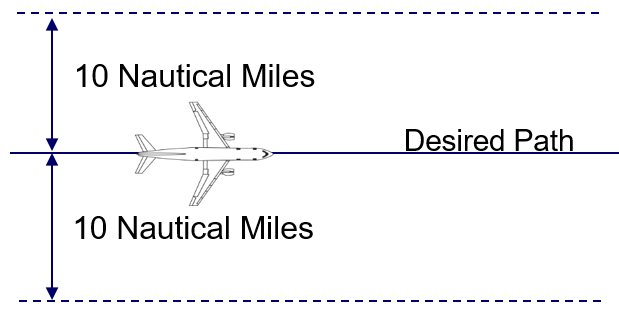There are two dedicated Nav Specs that support this phase of flight: RNAV 10 and RNP 4. Both certification standards already existed when ICAO started to develop the PBN concept and it is for that reason that aircraft are certififed to RNP 10, although the Nav Spec does not require on-board performance monitoring and alerting (OBPMA). Due to the cost of changing all the aircraft flight manuals as well as an extensive level of other documents, ICAO agreed to accept the term RNP 10 but fully understanding that the spec is RNAV 10.
RNP 2 and A-RNP can be taken into oceanic/remote continental areas but to do so, the aircraft operator/manufacturer must demonstrate that the aircraft has the correct surveillance and communications equipment fitted as well as redundancy in the navigation systems; this redundancy is provided by dual systems being independently fitted to the aircraft. Dual systems are referred to as High Continuity.
RNAV 10 supports 50 NM lateral and the 50 NM longitudinal distance based separation minima in oceanic or remote area airspace. The titled RNAV 10 is used for consistency within the PBN manual. The designation does not affect operators who had already obtained an RNP 10 authorization from their regulatory authority. RNAV 10 does not require on-board performance monitoring and alerting. The designation of the airworthiness and operational approval as well as airspace/route designation remains “RNP 10” in order to retain the validity of the present publications and extensive approvals.

ICAO recognises the extent of existing airspace designations and operational approvals under RNP 10 designation and it is anticipated that any new aircraft approvals will continue to use the term RNP 10 while the required PBN application is known as RNAV 10.
RNAV 10 requires that aircraft operating in oceanic and remote areas be equipped with at least two independent and serviceable LRNSs comprising an INS, an IRS FMS or a GNSS, with an integrity such that the navigation system does not provide an unacceptable probability of misleading information.
RNP 4 was initially an operator's option rather than a requirement to allow low separation standards to be applied. Originally RNP 4 was developed to support the 30 NM lateral and 30 NM longitudinal distance-based separation minima in oceanic or remote area airspace. This standard has been revised in PANS ATM Chapter 5, and now the lateral separation standard is 23 NM. The aircraft must be fitted with CPDLC, or have direct controller pilot communications (DCPC - voice) and automatic dependent surveillance contract (ADS-C). Further separation standards using space-based ADS-B and RCP 240 with RNP 4 have been developed and these were published in PANS ATM (ICAO Doc 4444, Chapter 8.7.4) in November 2020.

For RNP 4 operations in oceanic or remote airspace, at least two fully serviceable independent LRNSs, with integrity such that the navigation system does not provide misleading information, must be fitted to the aircraft and form part of the basis upon which RNP 4 operational approval is granted. GNSS must be used and can be used as either a stand-alone navigation system or as one of the sensors in a multi-sensor system.
During operations on designated RNP 4 ATS routes, the lateral Total System Error (TSE) must be within +/- 4 NM for at least 95% per cent of the total flight time. The probability of the system not giving an alert when the estimated position exceeds the required performance (+/- 4 NM) of the route is 1 time in 10 000 000 per flight hour or 10-7 in normal operations.